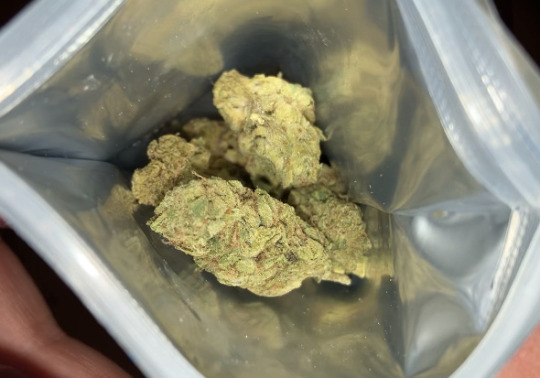#cannabisresearch
Text

Just a lil joint after work never hurt
#420culture#420daily#420stoner#weed mention#weed strains#weedlife#weedsociety#weedstagram#420life#420photography#weed joints#weedwitch#weedporn#smoke weed everyday#weedhumor#weed#cannabisculture#cannabisresearch#cannalife#cannacommunity#cannabusiness#cannabis
64 notes
·
View notes
Text
Marijuana for Mental Health Treatment: Unveiling the Scientific Insights
Marijuana, also known as cannabis, has long been associated with recreational use. However, recent scientific research has shed light on its potential therapeutic benefits, particularly in the realm of mental health treatment. In this article, we will delve into the scientific evidence surrounding marijuana's effects on mental health and explore three compelling facts that highlight its potential as a treatment option. Discover the intriguing possibilities that may pave the way for a new approach to mental health care.
Facts and Evidence:
Anxiety and Stress Reduction:
Studies suggest that certain components of marijuana, such as cannabidiol (CBD), may help alleviate symptoms of anxiety disorders.
CBD has shown promise in reducing anxiety levels and improving overall well-being, making it a potential alternative or adjunct to traditional anxiety medications.
Pain Management and Mood Enhancement:
Marijuana's active compounds, particularly tetrahydrocannabinol (THC), have been found to have analgesic properties, providing relief for chronic pain conditions.
Additionally, THC has shown mood-enhancing effects, potentially aiding individuals with mood disorders such as depression or bipolar disorder.
PTSD Symptom Relief:
Research suggests that marijuana may be beneficial for individuals with post-traumatic stress disorder (PTSD).
The cannabinoids in marijuana interact with the endocannabinoid system, which plays a role in regulating fear, anxiety, and memory, potentially reducing PTSD symptoms.
To delve deeper into the scientific evidence supporting the use of marijuana for mental health treatment, and to gain a comprehensive understanding of its potential benefits and considerations, click the link below.
#Marijuana#MentalHealth#TherapeuticBenefits#CannabisResearch#AnxietyTreatment#StressReduction#PainManagement#MoodEnhancement#DepressionRelief#PTSDTreatment#AlternativeMedicine#Neuroscience#Cannabinoids#EndocannabinoidSystem#ScienceBehindMarijuana
5 notes
·
View notes
Photo

The plays a crucial role in regulating various physiological and cognitive processes, and may help reduce inflammation and protect the brain from damage caused by cerebral palsy. 🤔🧠
0 notes
Text
THC Gummies and Anxiety: Exploring the Connection 🌿😌
Delve into the relationship between THC gummies and anxiety. Learn about the potential effects, benefits, and considerations when using these products.
Refer Link - https://justpaste.it/thc-gummies-and-anxiety
#THCGummies#AnxietyRelief#CannabisAndMentalHealth#THCProducts#CannabisWellness#AnxietyManagement#CannabisEffects#HolisticHealth#CannabisResearch#WellnessInsights
0 notes
Text
Definition of Diversified Farming: Understanding the Practice of Diversification
Diversified farming, also known as mixed farming, is an agricultural practice that involves the cultivation of multiple crops and/or the raising of various livestock within a single farm operation. This approach aims to reduce risk, increase productivity, and promote sustainability by harnessing the complementary relationships between different crops and animals. Diversified farming seeks to create a balanced and integrated ecosystem on the farm, where each element contributes to the overall resilience and success of the agricultural system.
In diversified farming systems, farmers strategically combine various crops, such as grains, vegetables, fruits, and forage, with livestock, including cattle, poultry, sheep, or goats. The different components of the farm interact synergistically, benefiting from each other's presence. For example, livestock can provide manure and grazing services that enrich the soil and reduce the need for synthetic fertilizers. In return, the crops can serve as feed for the animals, completing a nutrient cycle that fosters a more sustainable and self-sufficient farming operation.
The practice of diversified farming offers several advantages over monoculture, where only one crop is grown on a large scale. Some key benefits include:
Risk Mitigation: By diversifying their production, farmers are less vulnerable to market fluctuations, climate extremes, and pest or disease outbreaks that may impact a single crop. If one crop fails, other components of the farm can help maintain income and food production.
Enhanced Soil Health: The rotational nature of diversified farming helps maintain soil fertility and structure. Different crops have varying nutrient requirements, preventing excessive nutrient depletion and reducing the likelihood of soil degradation.
Reduced Input Dependency: Diversified farming often relies on organic and natural inputs, such as compost, cover crops, and crop residues, reducing the need for synthetic fertilizers and pesticides.
Biodiversity Conservation: Diversified farming encourages the preservation of biodiversity on the farm. Different crops and habitats support a wide range of beneficial insects, pollinators, and wildlife.
Improved Food Security: The production of diverse crops and livestock enhances food security by providing a variety of nutritious foods for consumption and potential sale.
Market Opportunities: Diversified farms can tap into multiple markets, catering to diverse consumer demands for various products.
Overall, diversified farming represents a holistic approach to agriculture, promoting environmental sustainability, economic stability, and resilience in the face of ever-changing challenges. It fosters a deeper connection between the farmer, the land, and the community, reinforcing the importance of a balanced and harmonious relationship between agriculture and nature.
#diversified farming#farming#agriculturetechnology#farmer#agriculture#farmingtechnologies#agriculture technology#cannabisresearch#agripreneur
0 notes
Photo

Did you know that July is National Hemp Month? You can tell how we're celebrating! 🔥🐲 Speaking of cannabis, check out our new Cannabis 101 Blog Post: Full, Broad, and Isolated Cannabis Products! Are you wondering what all of these specific terms mean when it comes to your favorite cannabis products? Or are you having difficulty selecting the right products for you? We now have a comprehensive guide and a great introduction to the wide variety of cannabis on the market! https://www.snapdragonhemp.com/comparing-full-broad-and-isolated-cannabis-products/
#snapdragonhemp#nationalhempmonth#snapdragon#chattanooga#tennessee#chattanoogacbd#hemp#ntlhempmonth#cannabisbasics#cannabisresearch#cannabis101#tennesseehemp
1 note
·
View note
Photo

Good information @tumigenomics ・・・ The foundation of a clean stock program begins with the identification and maintenance of clean mother plants. A clean mother plant, also known as ‘foundation-level’ or ‘G1’, is a cultivar that has tested negative for all economically harmful plant pathogens and is maintained with heightened phytosanitary protocols, in specifically designated facilities and monitored by a selected workforce who only work on that facility. From these clean stock plants, the mother plant population is expanded to meet the production needs of the facility. Beginning each cultivation run with disease-free mother plants is critical for crop success. TUMI Genomics' recommendations for the creation and maintenance of this clean stock are based on established clean stock programs in general agriculture. DM us if you would like to know more about how we can help you design a clean stock program in your operation or visit our website <<< link in bio #Science #Agriculture #Pathogens #CannabisScience #HLVd #CannabisEducation #CannabisResearch #viroid #TUMIGenomics (at Washington Heights (Manhattan)) https://www.instagram.com/p/CqbdBPErE0P/?igshid=NGJjMDIxMWI=
#science#agriculture#pathogens#cannabisscience#hlvd#cannabiseducation#cannabisresearch#viroid#tumigenomics
0 notes
Text
Feeling like a #BlackDiamond in the sky - this strain is sure to take you to new heights!
Visit our Etsy store and get your digital copy of the digital poster art https://highendstrainart.com/c6j9
#CannabisCommunity#CannabisCulture#CannabisLifestyle#CannabisLegalization#CannabisIndustry#CannabisMedicine#CannabisOil#CannabisGrowers#CannabisEdibles#CannabisConcentrates#CannabisInfused#CannabisProducts#CannabisEducation#CannabisAdvocacy#CannabisResearch#CannabisBusiness#CannabisLaw
0 notes
Photo

Exciting news everyone! I just finished a camera shoot with Glenn Jones at @nbcnews (@nbc10boston) where I had the opportunity to share my passion for the cannabis industry, and educate the public, through the camera, about its benefits . But the real highlight of the day was sharing the secret sauce, which is one amazing patient, in particular, who bravely shared her success story with cannabis. She endured years of pain and frustration with the broken medical system, but now manages her pain with a regular cannabis routine. This is why I do what I do - to help patients find relief and live their best lives! #medicalcannabis #cannabisdoctor #painmanagement #cannabiscommunity #patientstory #healthylifestyle #cannabisadvocate #cannabiseducation #medicalmarijuana #cannabisismedicine #naturalmedicine #healthandwellness #cannabisforpain #cannabisforhealing #breakingthestigma #cannabisresearch #cannabisindustry #cannabisculture #womenincannabis #plantmedicine #holistichealth #endocannabinoidsystem #cbd #thc #weedstagram #cannabisnews #cannabissuccessstories #cannabisheals #cannabisrevolution https://www.instagram.com/p/CpTFO3du9yh/?igshid=NGJjMDIxMWI=
#medicalcannabis#cannabisdoctor#painmanagement#cannabiscommunity#patientstory#healthylifestyle#cannabisadvocate#cannabiseducation#medicalmarijuana#cannabisismedicine#naturalmedicine#healthandwellness#cannabisforpain#cannabisforhealing#breakingthestigma#cannabisresearch#cannabisindustry#cannabisculture#womenincannabis#plantmedicine#holistichealth#endocannabinoidsystem#cbd#thc#weedstagram#cannabisnews#cannabissuccessstories#cannabisheals#cannabisrevolution
0 notes
Text

Gelonade
Personal review of Gelonade
Gelonade is a strain very unique, coming in with an average 24 THC percentage and is a cross between Lemon Tree and Gelato #41. It has sweet and earthy tones to it and all around is an enjoyable smoke. Personal review of the strain Gelonade
My personal takeaways from this strain were very enjoyable. This strain has a very enjoyable head and body high, helping me relax and feel less anxious while I was still able to smoke and do tasks I needed to do.
I personally like to test the way a high feels on me by being able to do tasks around the home ; cleaning, cooking, organizing and other chores. Seeing if I’m staying on task or if I find myself drifting away. The second test I like to do is sitting down and playing a puzzle game. Seeing how long said game will take me and if I have the attention span to finish it.
Gelonade helped with my focus of completing house hold chores and focusing on puzzles for long periods of time. One of the downsides to Gelonade in my personal opinion was the high personally did not last very long and only stayed peek for half a hour to forty minutes and made me incredibly hungry, That is a personal downside but may be what others would like to achieve from their high.
All around Gelonade is a really great smooth strain, leaving very little irritation on the back of my throat and very little coughing that is slowly becoming a personal favorite of mine.
-Stone
All info about strain genetics found at Leafly.com
#420culture#420daily#420stoner#weed mention#weed strains#weedlife#weedsociety#weedstagram#420life#420photography#cannabisculture#cannacommunity#cannabusiness#cannalife#weed strain#strain review#cannabis education#cannabisresearch#sativa#indica#hybrid
34 notes
·
View notes
Text


Teenagers and Cannabis Use: Studies show that early and frequent marijuana use among teenagers may have long-term impacts on brain development, memory, and academic performance. It is crucial to prioritize education, prevention, and open communication to address potential risks.
Adults and Therapeutic Benefits: Marijuana has gained recognition for its potential therapeutic benefits in managing various conditions, such as chronic pain, anxiety, and epilepsy, among adults. Continued research and responsible use can contribute to exploring its medicinal applications further.
Older Adults and Symptom Management: Older adults are increasingly turning to marijuana for symptom relief, particularly for age-related ailments like chronic pain and sleep issues. However, considerations such as drug interactions, individual health conditions, and proper dosage should be carefully evaluated.
Read Full Article, Click The Link
#MarijuanaUse#CannabisInsights#AgeGroups#CannabisResearch#MarijuanaEffects#CannabisCommunity#WeedCulture#MarijuanaLifestyle#CannabisAwareness#MarijuanaEducation
4 notes
·
View notes
Photo

More research is being done into the therapeutic potential of cannabis. has been approved by the FDA for rare forms of epilepsy, and clinical trials are investigating its benefits for chronic pain, MS, and cancer. 📚💊
0 notes
Text
The Benefits of Vertical Farming: Enhancing Agriculture for a Sustainable Future
Maximizing Land Use: Vertical farming efficiently utilizes limited land resources, especially in urban areas where available farmland is scarce.
Year-Round Crop Production: Controlled environments in vertical farms allow for year-round cultivation, providing a constant supply of fresh produce regardless of external weather conditions.
Reduced Environmental Impact: Vertical farming reduces the need for long-distance transportation of food, lowering greenhouse gas emissions and the overall carbon footprint.
Water Efficiency: Vertical farming systems, such as hydroponics and aeroponics, use significantly less water compared to conventional soil-based farming.
Pest and Disease Control: Controlled environments in vertical farms minimize the need for chemical pesticides and herbicides.
Reduced Land and Soil Degradation: Vertical farming does not require traditional plowing or tilling of soil, preserving soil structure and preventing erosion.
Optimal Resource Management: Vertical farms can fine-tune environmental factors to suit specific crop requirements, resulting in higher yields and better-quality produce.
Food Security and Resilience: Vertical farming enhances food security in urban areas by producing food locally and year-round.
Crop Variety: Vertical farming enables the cultivation of a wide range of crops, providing consumers with a variety of fresh produce options.
Potential for Sustainable Urban Development: Integrating vertical farms into urban spaces can contribute to sustainable urban development by repurposing underutilized buildings and transforming them into productive spaces.
#Vertical farming#farmer#agriculturetechnology#farming#agripreneur#farmingtechnologies#organicfarmer#agriculture#cannabisresearch#organicfarmerofmillionaire#agriculture technology
0 notes
